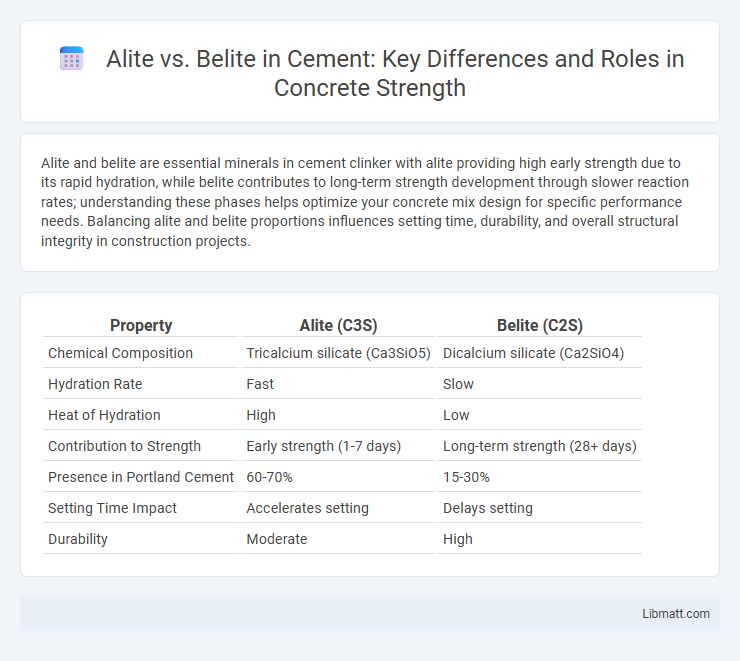Alite and belite are essential minerals in cement clinker with alite providing high early strength due to its rapid hydration, while belite contributes to long-term strength development through slower reaction rates; understanding these phases helps optimize your concrete mix design for specific performance needs. Balancing alite and belite proportions influences setting time, durability, and overall structural integrity in construction projects.
Table of Comparison
| Property | Alite (C3S) | Belite (C2S) |
|---|---|---|
| Chemical Composition | Tricalcium silicate (Ca3SiO5) | Dicalcium silicate (Ca2SiO4) |
| Hydration Rate | Fast | Slow |
| Heat of Hydration | High | Low |
| Contribution to Strength | Early strength (1-7 days) | Long-term strength (28+ days) |
| Presence in Portland Cement | 60-70% | 15-30% |
| Setting Time Impact | Accelerates setting | Delays setting |
| Durability | Moderate | High |
Introduction to Alite and Belite
Alite and belite are the primary mineral phases in Portland cement clinker, crucial for cement hydration and strength development. Alite, characterized by its chemical composition C3S (tricalcium silicate), is responsible for early strength gain due to its rapid hydration. Belite, known as C2S (dicalcium silicate), hydrates more slowly, contributing to the long-term strength and durability of hardened cement.
Chemical Composition: Alite vs Belite
Alite (C3S) primarily consists of calcium silicate with a chemical formula of 3CaO*SiO2, featuring higher calcium oxide (CaO) content and more reactive silicate phases compared to Belite. Belite (C2S), with a formula of 2CaO*SiO2, contains lower CaO levels and more stable silicate structures, resulting in slower hydration rates. The distinct chemical compositions directly influence their roles in cement hydration, where Alite contributes to early strength and Belite to long-term strength development.
Formation and Occurrence in Cement
Alite (C3S) forms at higher temperatures above 1250degC in the cement kiln, characterized by rapid cooling that preserves its crystallinity, whereas Belite (C2S) forms at lower temperatures between 900degC and 1200degC through slower cooling processes. Alite is the predominant phase in ordinary Portland cement responsible for early strength development, comprising roughly 50-70% of clinker, while Belite contributes to long-term strength with a content of about 15-30%. The differential formation conditions of Alite and Belite directly influence their occurrence and reactivity in cement clinker, impacting hydration kinetics and strength evolution in concrete.
Crystal Structure Differences
Alite and belite, both crucial components of Portland cement clinker, exhibit distinct crystal structures influencing their reactivity and hydration kinetics. Alite (tricalcium silicate, C3S) crystallizes in a monoclinic or triclinic system, characterized by a dense and compact lattice that contributes to its rapid hydration and early strength development. In contrast, belite (dicalcium silicate, C2S) features a rhombohedral or triclinic crystal structure with a more open and less dense lattice, resulting in slower hydration rates and contributing to the long-term strength of cement.
Role in Cement Hydration
Alite (C3S) primarily drives early strength development in cement hydration by rapidly reacting with water to form calcium silicate hydrate (C-S-H) and calcium hydroxide, contributing to initial setting and early strength gain. Belite (C2S) hydrates more slowly, producing C-S-H over an extended period, which enhances long-term strength and durability of the cement. The balance between alite and belite phases determines the overall performance timeline of hydraulic cement systems.
Strength Development: Alite vs Belite
Alite (C3S) contributes to rapid strength development in cement within the first 7 days due to its fast hydration rate, providing early structural integrity. Belite (C2S) hydrates more slowly, leading to strength gain over an extended period, typically enhancing long-term durability beyond 28 days. Understanding the balance between Alite and Belite phases in your cement mix optimizes both initial strength and long-term performance.
Reactivity and Setting Times
Alite (C3S) exhibits higher reactivity and primarily controls the early strength development of cement due to its rapid hydration, causing shorter setting times compared to Belite (C2S). Belite hydrates more slowly and contributes to strength growth over a longer period, resulting in extended setting times and increased durability. These differences in reactivity and setting behavior are critical for optimizing cement formulations for specific construction requirements.
Impact on Durability and Performance
Alite, a primary component of Portland cement, significantly enhances early strength development and long-term durability due to its rapid hydration rate and high calcium silicate content. Belite hydrates more slowly, contributing to strength gain over an extended period and improving overall toughness and resistance to chemical attack. Understanding the balance between alite and belite in your cement mixture can optimize performance, ensuring structural integrity and longevity in various construction applications.
Environmental Considerations
Alite and Belite are key components of Portland cement with distinct environmental impacts; alite (C3S) contributes to rapid strength development but requires higher kiln temperatures, leading to greater CO2 emissions during production. Belite (C2S) forms at lower temperatures, emitting less CO2 and offering improved long-term strength and durability, which enhances sustainability by reducing material consumption and maintenance needs. Utilizing belite-rich cements supports lower carbon footprints and aligns with environmentally conscious construction practices by minimizing greenhouse gas emissions.
Summary: Choosing Alite or Belite
Alite and belite are the primary calcium silicate phases in Portland cement, with alite (C3S) providing rapid strength development and early hydration, while belite (C2S) contributes to long-term strength and durability. Your choice depends on construction needs: alite-rich cement suits projects requiring quick setting and high early strength, whereas belite-rich cement favors sustainability and slower strength gain with enhanced durability. Understanding their hydration rates and mechanical properties helps optimize cement formulation for specific structural performance and environmental goals.
Alite vs Belite Infographic

 libmatt.com
libmatt.com